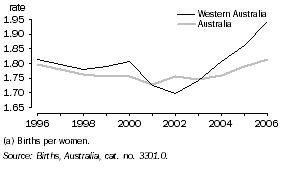 SOCIAL TRENDS
SOCIAL TRENDS
FAMILIES AND HOUSEHOLDS
Marriages and divorces
In 2006, 11,600 marriages were registered in Western Australia, an increase of 500 (4.3%) from 2005. All states and territories recorded an increase in registered marriages Western Australia ranked third behind New South Wales (6.0%) and Victoria (5.1%). The crude marriage rate (the number of marriages per 1,000 of the estimated resident population) for Western Australia also increased from 5.5 in 2005 to 5.6 in 2006. This was lower than the rate in 1996 (5.8).
Of all marriages in Western Australia, more than two thirds (67.1%) were first time marriages for both partners (compared to 68.5% nationally). The median age for first time marriage for both males and females decreased slightly in Western Australia. In 2006, the median age was 29.9 years for men and 27.7 years for women, compared to 30.3 and 28.3 years respectively in 2005. In 1996, the respective median ages for first time marriage were 27.8 and 25.8 years.
In Western Australia, there were 5,500 divorces in 2006. The crude divorce rate (the number of divorces per 1,000 of the estimated resident population) declined from 2.8 in 1996 to 2.7 in 2006. The median duration between marriage and divorce has increased from 8.4 years in 1996 to 9.6 years in 2006.
Fertility
There were 27,800 births registered in Western Australia in 2006. This was 5.8% higher than in 2005 (26,300 births), 9.8% higher than in 2004 (25,300 births) and 12.0% higher than in 1996 (24,800). The total fertility rate (TFR) represents the number of babies that a woman could expect to bear during her reproductive lifetime based on current age-specific fertility trends. The TFR in Western Australia had generally decreased over a long period falling to a low of 1.70 in 2002. However, it has since increased, reaching 1.86 in 2005 and 1.94 in 2006. Apart from a short period between 2001 and 2003 the TFR for Western Australia has been higher than for Australia over the past decade. Australia's TFR was 1.81 in 2006.
TOTAL FERTILITY RATE(a)

A recent trend has been the increase in births to mothers aged more than 35 years. In Western Australia, the proportion increased from 13.6% in 1996 to 20.8% in 2006. There have been small fluctuations in the proportion of births to mothers aged under 20 years over the same period (5.7% in 1996 and 5.0% in 2006).
Families and work
In June 2007, 11.8% of children aged under 15 years (49,200) in Western Australia were living in families where no parent was employed, decreasing from 16.3% in June 1997. Over the same period the proportion of couple families with neither parent employed fell from 6.1% to 3.5%. In June 2007, more than half (56.4%) of couple families with children aged under 15 years had both parents employed, which has steadily increased from 53.1% in 1997. The proportion of lone parent families, where the parent was employed, increased from 43.3% to 60.3% over the same period.
 Print Page
Print Page
 Print All
Print All